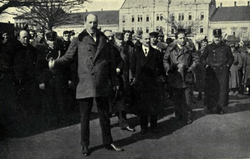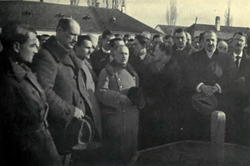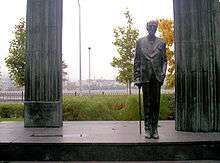Mihály Károlyi
| Mihály Károlyi | |
|---|---|
 | |
| 1st President of Hungary | |
|
In office 11 January 1919 – 21 March 1919 Acting: 16 November 1918 – 11 January 1919 | |
| Prime Minister | Dénes Berinkey |
| Preceded by | Position Established |
| Succeeded by | Sándor Garbai |
| 20th Prime Minister of Hungary | |
|
In office 31 October 1918 – 11 January 1919 | |
| Monarch |
Charles IV Archduke Joseph as Regent |
| President | himself |
| Preceded by | János Hadik |
| Succeeded by | Dénes Berinkey |
| Personal details | |
| Born |
Ádám György Miklós Károlyi de Nagykároly 4 March 1875 Fót, Kingdom of Hungary, Austria-Hungary |
| Died |
19 March 1955 (aged 80) Vence, France |
| Political party | National Independence Kossuth Party |
| Spouse(s) | Katinka Andrássy |
| Children |
Éva Ádám Judit |
Count Mihály Ádám György Miklós Károlyi de Nagykároly (4 March 1875 – 19 March 1955) was briefly Hungary's leader from 1918 to 1919 during the short-lived First Hungarian People's Republic. He served as Prime Minister between 1 and 16 November 1918 and as President between 16 November 1918 and 21 March 1919.
Background and early career

The Károlyi family were an illustrious, extremely wealthy, Roman Catholic aristocratic family who had played an important role in Hungarian life since the 17th century. Mihály was born in Fót, Austria-Hungary in what is today Hungary. In his youth, he was a wastrel, but as he grew older, he became devoted to more serious pursuits. In 1909, he became the President of the OMGE (National Agricultural Society), the main rural organization of the nobility. Initially a supporter of the existing politico and social system in Hungary, Károlyi gradually became more progressive and left-wing during his career.
In 1910, Károlyi was elected to Parliament as a member of the opposition Party of Independence.
World War I
During the First World War, the pro-Entente Károlyi led a small but very active pacifist anti-war maverick faction in the Hungarian parliament.[1] Károlyi made contact with British and French Entente diplomats behind the scenes in Switzerland during the war.[2] The Károlyi Party was always a weak group with no mass organization and only 20 members in Parliament, most of whom had little commitment to the party. Károlyi argued for peace with the Allies, looser ties between Austria and Hungary, abolishing the franchise and language requirements that allowed only 5.8% of the male population to vote and run for office before the war, and giving women the right to vote and hold office. In particular, Károlyi's demand in 1915 that veterans should be granted the right to vote won so much popular support that enraged the Prime Minister, Count István Tisza. In 1916 Károlyi broke off with his party, which had found his openly pro-ENTENTE attitude to be too radical and dangerous for a war-time pacifist faction. Károlyi formed a new party, called the United Party of Independence and of 1848, and generally known as the Károlyi Party.
In January 1918, Károlyi proclaimed himself a follower of Woodrow Wilson's Fourteen Points.
Marriage and family
On 7 November 1914 in Budapest, Károlyi married Countess Katalin Andrássy de Csíkszentkirály et Krasznahorka, with whom he had three children. Károlyi's wife was a member of one of Hungary's most powerful families, and this marriage won Károlyi the protection of his influential father-in-law.
Leading the Democratic Republic
Following the Aster Revolution of October 1918, Károlyi became leader of the nation. On 25 October 1918 Károlyi had formed an opposition National Council. His reputation as an opponent of the much-hated war had thrust him into a role for which he was not suited. King-Emperor Charles IV designated him as Prime Minister as a part of a desperate attempt to hold Hungary on to the Habsburgs. Károlyi would have preferred to keep the monarchy and some link to Austria if possible. Only after Charles's withdrawal from government on 16 November 1918 made Károlyi proclaim the Hungarian Democratic Republic, with himself as Provisional President. On 11 January 1919 the National Council formally recognized him as President.
Many citizens thought that Károlyi could negotiate soft peace terms with the Allies for Hungary. Károlyi headed the Provisional Government from 1 November 1918 until 16 November, when the Hungarian Democratic Republic was proclaimed. Károlyi ruled Hungary through a National Council, transformed into the government that consisted of his party in alliance with the large Hungarian Social Democratic Party and the small Civic Radical Party led by Oszkár Jászi.
At the same time, there existed various revolutionary councils, which were dominated by the Social Democrats, which were not unlike the Soviets (Councils) that existed in Russia in 1917. This situation of Dual Power gave Károlyi responsibility without much power while giving the Social Democrats power without much responsibility.

During their brief periods in power, Károlyi and Jászi, who served as Nationalities Minister, tried to create an "Eastern Switzerland" by persuading the non-Magyar peoples of Hungary to stay as part of the new Hungarian Democratic Republic.
Additional trouble for the new government occurred over the question of the armistice. Austria-Hungary had signed the lenient Armistice of villa Giusti (close to Padua, Italy) with the Allies on 3 November 1918. Since Hungary was now independent, some in the Cabinet argued that Hungary needed to sign a new armistice. Against his better judgement, Károlyi agreed to this idea, and had Hungary sign in November 1918, a new armistice with the Allies in Belgrade with the Allied Commander in the Balkans, the French General Louis Franchet d'Esperey.
General Franchet d'Esperey treated the Hungarians with open contempt and imposed a much harsher armistice on the defeated nation than the Padua Armistice had. This was the source of much criticism of Károlyi, who had been expected – and who himself expected – the Allies to treat Hungary as a friend, not an enemy. Moreover, Károlyi's opponents argued that by needlessly seeking a second armistice, Károlyi had worsened Hungary's situation.
Furthermore, the Social Democrats who were Hungary's largest party by far, frequently undercut Károlyi and imposed their decisions on him without taking responsibility for their actions. Károlyi wished to transfer almost all of the rural lands to the peasants. To set an example, he gave all of his own vast family estates to his tenants. But this was the only land transfer that took place; the Social Democrats blocked any measures that might give the control of those lands to the peasantry on the grounds that it was promoting capitalism.

In another equally unfortunate move, the pacific-minded Károlyi had abolished almost all the Hungarian armed forces in November 1918. All through the winter of 1918–19, the Romanians, the Yugoslavs and the Czechoslovaks often broke the armistice in order to seize more territory for themselves. After January 1919, Károlyi ordered the build-up of a Hungarian army and started to consider the idea of an alliance with Soviet Russia, through Károlyi was opposed to the idea of Communism in Hungary itself.
In addition, as Hungary had signed an armistice, not a peace treaty, the Allied blockade continued until such time as a peace treaty was signed. Hungary had suffered from food shortages throughout the war and deaths from starvation had become common from 1917 onwards. Furthermore, the country had been overwhelmed with refugees from Transylvania and Galicia.
Making things worse was the creation of Czechoslovakia which had cut Hungary off from supplies of German coal. Hungary which possessed little coal depended upon German coal imports. Without coal, most had to live without heat in the winter of 1918–19, and the railroad network had gradually ceased to function. The collapse of railroads in their turn caused the collapse of industry and hence mass unemployment.
Making things even worse was the economic incompetence of the government which printed more and more money, leading to massive inflation and even more impoverishment. Károlyi's failure to improve living conditions or persuade the Allies to lift the blockade led to public criticism of Károlyi.
Baron Lajos Hatvany described Károlyi's leadership well when he noted "From the discussions no decisions arose, and from the decisions – no actions. A cabinet? No, it was a debating club".[3] In the same vein, the British writer Harold Nicolson, who had known Károlyi during his exile in Britain, when reviewing Károlyi's memoirs in 1957 noted that: "he had many qualities, but unfortunately lacked those for which a man is taken seriously by serious people".[4]
Sigmund Freud, the Austrian psychologist—who had known the two politicians personally—wrote about the assassination of István Tisza and the appointment of Mihály Károlyi as new prime minister of Hungary:
"I was certainly no adherent of the ancien regime, but it seems doubtful to me whether it is a sign of political shrewdness to beat to death the smartest of the many counts [Count Istvan Tisza] and to make the stupidest one [Count Mihaly Karolyi] president." [5]
On 20 March 1919 the French presented the Vix Note ordering Hungarian troops further back into Hungary; it was widely assumed that the military lines would be the new frontiers. Károlyi and Prime Minister Dénes Berinkey were now in an untenable position. Although they did not want to accept this French demand, they were in no position to reject it either. On 21 March, Berinkey resigned. Károlyi then announced that only the Social Democrats could form a new government. Unknown to Károlyi, however, the Social Democrats had merged their party with the Communists led by Béla Kun. Hours after Berinkey resigned, the newly merged Hungarian Socialist Party announced Károlyi's resignation and the formation of the Hungarian Soviet Republic. At that point, Károlyi accepted the fait accompli and retired from active politics.
Károlyi's cabinet
- Minister of Agriculture: Barna Buza
- Minister of Commerce: Ernő Garami
- Minister of Defense: Béla Linder (31 October 1918 to 9 November 1918); Albert Bartha (9 November 1918 to 12 December 1918; Mihály Károlyi (12 December 1918 to 29 December 1918; Sándor Festetics (29 December 1918 to 19 January 1919)
- Minister of Finance: Mihály Károlyi (31 October 1918 to 25 November 1918; Pál Szende (25 November 1918 to 19 January 1919)
- Minister of Food: Ferenc Nagy
- Minister of the Interior: Tivadar Batthyány (31 October 1918 to 12 December 1918; Vince Nagy (12 December 1918 to 19 January 1919)
- Minister of Justice: Barna Buza (31 October 1918 to 3 November 1918; Dénes Berinkey (3 November 1918 to 19 January 1919)
- King's Personal Minister: Tivadar Batthyány (31 October 1918 to 1 November 1918)
- Minister of Religion and Education: Márton Lovászy (31 October 1918 to 23 December 1918)
- Minister of Welfare and Labour: Zsigmond Kunfi (12 December 1918 to 19 January 1919)
- Minister Without Portfolio: Oszkár Jászi (31 October 1918 to 1 November 1918); Zsigmond Kunfi (31 October 1918 to 12 November 1918); Béla Linder (9 November 1918 to 12 December 1918)
- Minister Without Portfolio for Croatia-Slavonia and Dalmatia: Zsigmond Kunfi (6 November 1918 to 19 January 1919)
- Minister Without Portfolio for Nationalities: Oszkár Jászi (1 November 1918 to 19 January 1919)
Later life
On 1919 April 10, "Romanian troops began to invade Hungary to forestall reconquest of Transylvania. A provisional government was set up by Count Julius Karolyi (brother of Michael), Count István Bethlen, Admiral Horthy, and Archduke Joseph at Szeged (under French occupation)."[6]
In July 1919, Károlyi went into exile in France and during World War Two, in Britain. Throughout the Horthy era, Károlyi was in a state of official disgrace in his homeland.
In 1924, while Károlyi's wife was in the United States she came down with typhoid fever. Károlyi applied for a visa to come to the United States to visit her, but the State Department imposed a gag order, preventing him from giving any political speeches, as the State Department believed him to be a Communist. A year later, Countess Károlyi was denied a visa to visit the United States, but Secretary Kellogg of the State Department refused to explain on what grounds her visa denial was made.[7] Morris Ernst acted as Károlyi's lawyer for these issues.
In 1946, Károlyi, who by that time had become a socialist, returned to Hungary and from 1947–49 served as the Hungarian Ambassador to France. In 1949, he resigned in protest over the show trial and execution of László Rajk.
He wrote two volumes of memoirs in exile; Egy egész világ ellen ("Against the Entire World") in 1925 and Memoirs: Faith without Illusion in 1954.
He died in Vence, France.
Legacy

In 1975, a memorial to Károlyi, sculpted by Imre Varga, was installed in Budapest's Kossuth Lajos tér. In 2012, the government began renovation to the square to the way it looked before World War II, and Károlyi's statue was moved to Siófok.[8] At the same time, throughout Hungary, many cities changed the name of their own streets named after Mihály Károlyi. In Budapest for example the name of the prominent street in downtown, was changed from "Károlyi Mihály utca" to simply "Károlyi utca", removing the association with him.
Footnotes
- ↑ Robert Paxton; Julie Hessler (2011). Europe in the Twentieth Century. CEngage Learning. p. 129. ISBN 9780495913191.
- ↑ Deborah S. Cornelius (2011). Hungary in World War II: Caught in the Cauldron. Fordham University Press. p. 9. ISBN 9780823233434.
- ↑ Vermes, Gabor "The October Revolution In Hungary" from Hungary in Revolution edited by Ivan Volgyes Lincoln: University of Nebraska Press, 1971 page 49.
- ↑ Menczer, Bela "Bela Kun and the Hungarian Revolution of 1919" pages 299–309 Volume XIX, Issue #5, May 1969, History Today Inc: London page 301.
- ↑ Sigmund Freud; Sándor Ferenczi; Eva Brabant; Ernst Falzeder; Patrizia Giampieri-Deutsch (1993). " The Correspondence of Sigmund Freud and Sándor Ferenczi, Volume 2: 1914-1919. Harvard University Press. ISBN 9780674174191.
- ↑ Penfield Roberts, "Hungary", in William L. Langer (1948), ed., An Encyclopedia of History, Rev. Edition, Boston: Houghton Mifflin, p. 1014.
- ↑ THE CABINET: Law and Discretion, Time, Monday, Nov. 02, 1925
- ↑ Taking a stand on Kossuth square, Budapest Times
References
- Deak, Istvan "The Decline and Fall of Habsburg Hungary, 1914–18" pages 10–30 from Hungary in Revolution edited by Ivan Volgyes Lincoln: University of Nebraska Press, 1971.
- Menczer, Bela "Bela Kun and the Hungarian Revolution of 1919" pages 299–309 from History Today Volume XIX, Issue #5, May 1969, History Today Inc: London
- Pastor, Peter, Hungary between Wilson and Lenin: the Hungarian revolution of 1918–1919 and the Big Three, Boulder: East European Quarterly; New York: distributed by Columbia University Press, 1976.
- Szilassy, Sándor Revolutionary Hungary, 1918–1921, Astor Park. Fla., Danubian Press 1971.
- Vermes, Gabor "The October Revolution In Hungary" pages 31–60 from Hungary in Revolution edited by Ivan Volgyes Lincoln: University of Nebraska Press, 1971.
External links
- Mihály Graf Károlyi von Nagykárolyi at the Wayback Machine (archived October 27, 2009)
- Newspaper clippings about Mihály Károlyi in the 20th Century Press Archives of the German National Library of Economics (ZBW)
| Political offices | ||
|---|---|---|
| Preceded by János Hadik |
Prime Minister of Hungary 1918–1919 |
Succeeded by Dénes Berinkey |
| Preceded by Tivadar Batthyány |
Minister of Foreign Affairs 1918–1919 | |
| Preceded by Sándor Popovics |
Minister of Finance Acting 1918 |
Succeeded by Pál Szende |
| Preceded by Károly IV as King of Hungary |
Provisional President of Hungary 1918–1919 |
Succeeded by Sándor Garbai as Chairman of the Hungarian Central Executive Council |
| Wikimedia Commons has media related to Mihály Károlyi. |